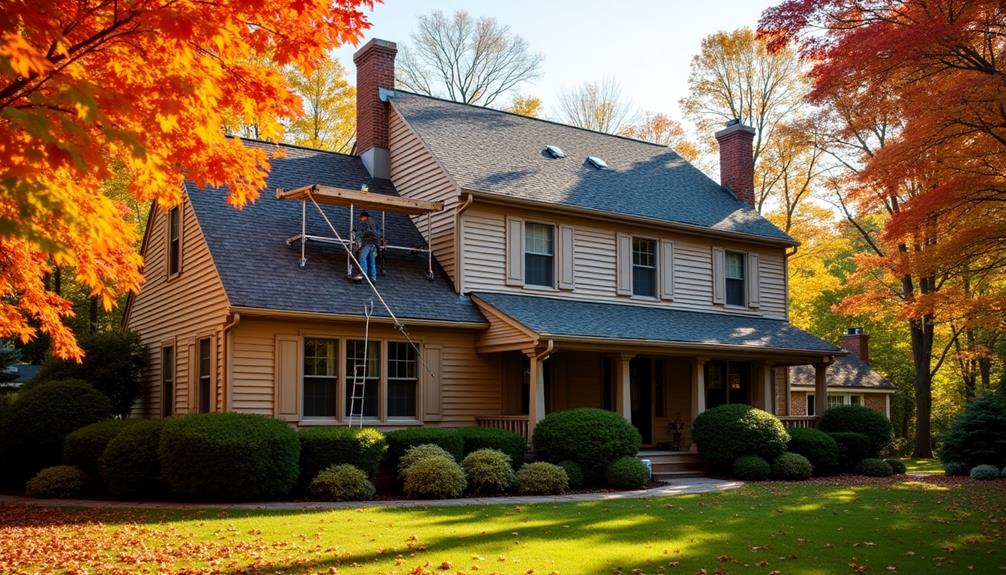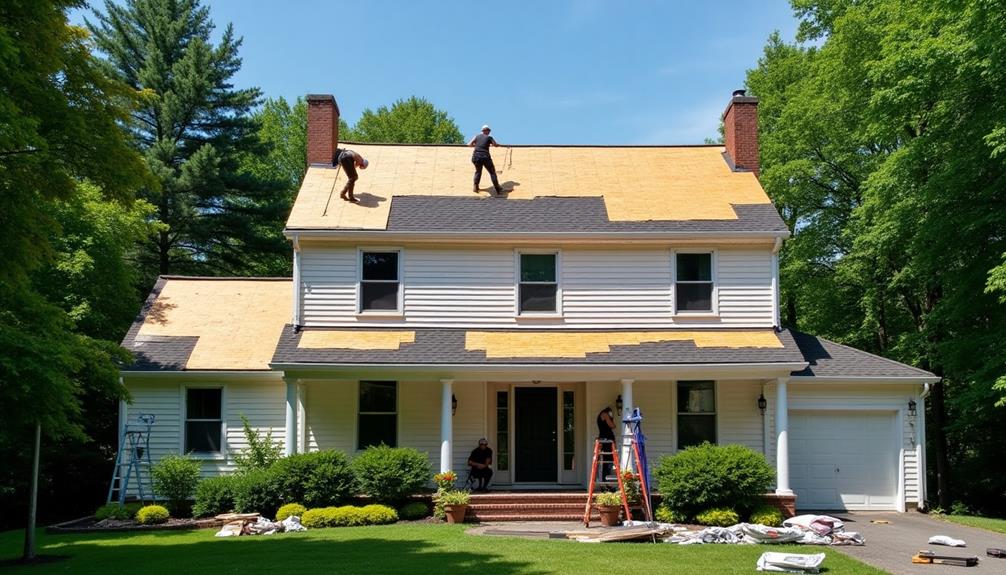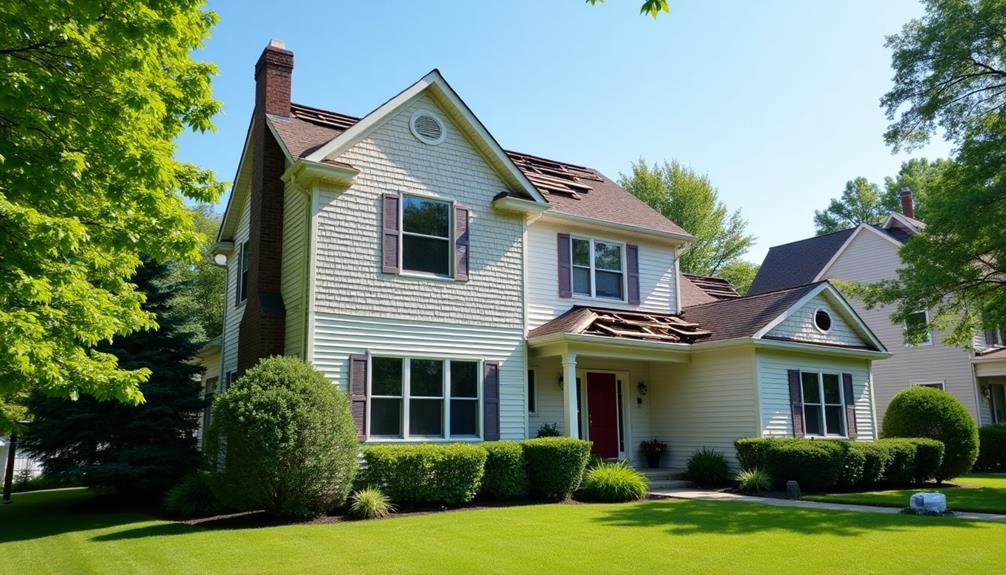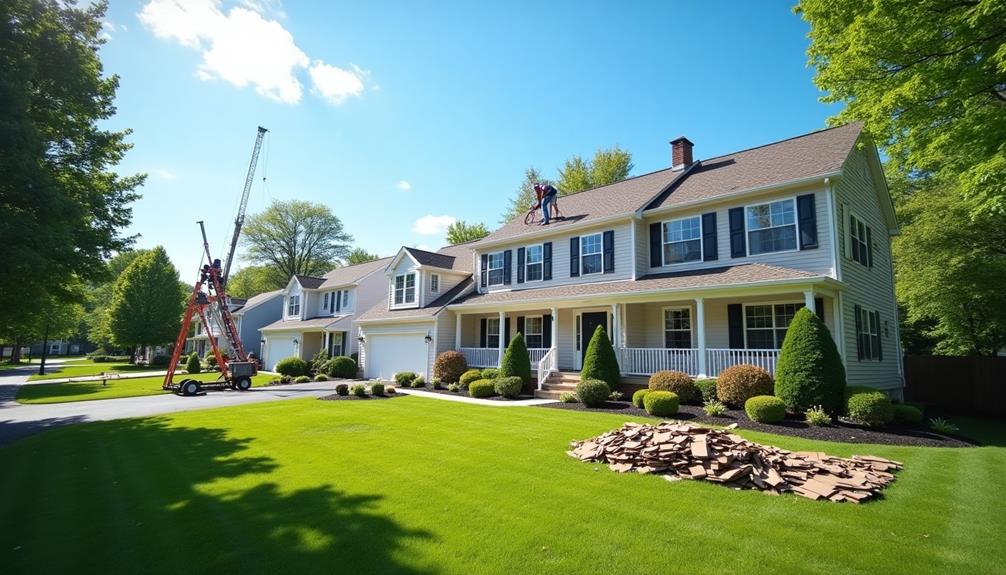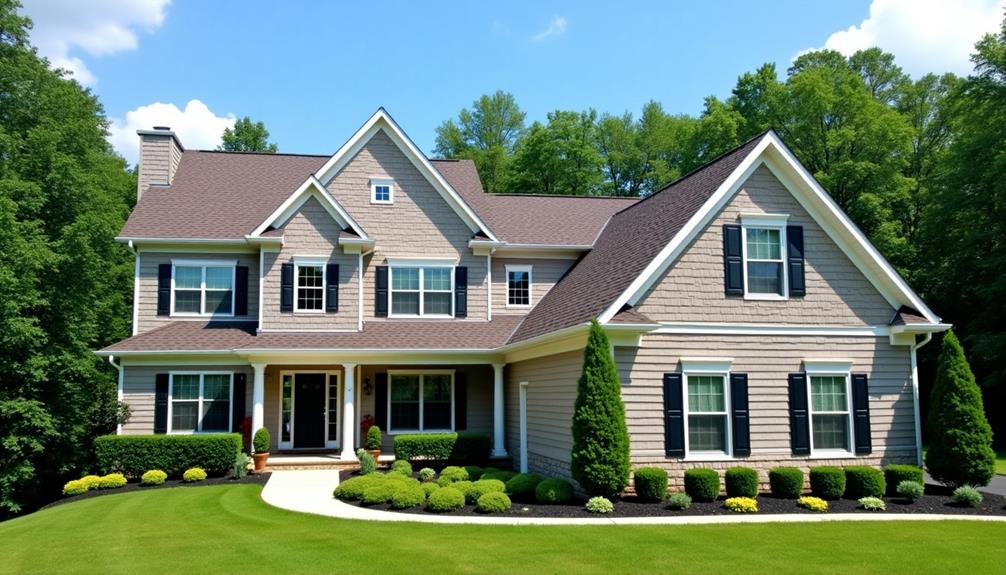When considering a flat roof for your home, you'll find both appealing benefits and significant drawbacks. On one hand, the cost-effective installation and potential for creating usable outdoor spaces can be enticing. On the other hand, issues like water pooling and increased maintenance may raise concerns. You might wonder how these factors will impact your home's value and longevity. As you weigh these aspects, it's essential to explore what truly matters for your lifestyle and budget. So, what will you choose?
Overview of Flat Roofs
When considering roofing options, flat roofs are a popular choice for both residential and commercial buildings. Their structure offers significant design flexibility, allowing you to utilize the space above for various purposes, such as rooftop gardens, solar panels, or even outdoor living areas. This versatility can enhance the functionality of your property.
Flat roofs also provide various insulation options that can improve energy efficiency. You can choose from materials like rigid foam or spray foam insulation, which can effectively minimize heat loss during colder months, reducing your energy bills. The flat surface allows for easy installation of insulation, ensuring a consistent thermal barrier across the roof.
Additionally, flat roofs are generally easier and safer to access than sloped roofs, making maintenance and repairs more straightforward. However, it's crucial to consider proper drainage systems, as flat roofs can be prone to water pooling if not designed correctly.
While they offer numerous benefits, understanding their specific requirements and potential drawbacks will help you make an informed decision. Overall, flat roofs present a practical solution that caters to modern architectural needs and enhances energy efficiency.
Aesthetic Appeal
Flat roofs can significantly enhance the aesthetic appeal of a building, offering a sleek and modern look that complements contemporary architecture. This design style allows for greater design flexibility, enabling you to create an eye-catching exterior that stands out in your neighborhood.
With clean lines and minimalistic features, flat roofs often convey a sense of sophistication and elegance.
Moreover, they foster urban integration, seamlessly blending into metropolitan landscapes where space is at a premium. A flat roof can serve as an additional outdoor living area, such as a rooftop garden or terrace, enhancing both the visual appeal and functionality of your home. This connection with the urban environment can help create a cohesive look with surrounding structures.
Installing a flat roof also allows you to experiment with various materials and colors, further enhancing your home's unique aesthetic. By choosing the right finish, you can make a bold statement or achieve a more subdued appearance, depending on your tastes.
Ultimately, the aesthetic benefits of flat roofs can transform your home, making it not only visually pleasing but also an integral part of its surroundings.
Cost-Effectiveness
When considering a flat roof, you need to weigh initial installation expenses against long-term maintenance costs.
While flat roofs can be more affordable to install, their ongoing upkeep and energy efficiency can significantly impact your overall budget.
Understanding these factors will help you determine whether a flat roof is the most cost-effective option for your needs.
Initial Installation Expenses
The initial installation expenses of a flat roof can significantly impact your budget, making it crucial to understand the cost-effectiveness of this roofing option.
When considering flat roofs, you'll find that the choice of installation materials plays a vital role in determining costs. Common materials like EPDM, TPO, and PVC each have varying price points, so evaluating these options is essential for staying within your budget.
In addition to material costs, labor expenses can also affect your overall budget considerations. Flat roofs generally require less labor compared to pitched roofs, which may lead to lower installation costs.
However, the complexity of your home's design and the accessibility of the roof can influence labor rates.
Don't forget to factor in potential permit fees and other local regulations that may apply to your installation. These could add to your initial expenses, so it's wise to conduct thorough research beforehand.
Ultimately, while the initial installation of a flat roof can be appealing due to potentially lower costs, understanding all related expenses will help you make an informed decision that aligns with your financial plan.
Long-Term Maintenance Costs
Understanding long-term maintenance costs is essential for evaluating the overall cost-effectiveness of a flat roof. While the initial installation might seem affordable, ongoing maintenance can impact your budget significantly over time.
Flat roofs require regular care to ensure longevity, which typically includes seasonal inspections and timely repairs. You'll want to establish a routine for these inspections, ideally at the beginning of each season. This proactive approach helps identify potential issues early, reducing the risk of extensive damage.
Common repair techniques might involve patching leaks, replacing damaged membranes, or addressing drainage problems. The frequency and nature of these repairs can vary based on material choice and local climate conditions.
For instance, an EPDM roof may require less maintenance than a built-up roof, which could lower your long-term costs. However, neglecting maintenance could lead to more significant issues, driving up repair expenses and possibly requiring a complete roof replacement sooner than expected.
Energy Efficiency Savings
Flat roof systems can offer significant energy efficiency savings, making them a cost-effective choice for many homeowners and businesses.
One of the key advantages of flat roofs is their ability to support solar panels effectively. By installing solar panels on a flat roof, you can harness renewable energy, reducing your dependence on traditional power sources and lowering utility bills.
Additionally, the insulation options available for flat roofs can enhance energy efficiency. You can choose from various insulation materials, such as rigid foam or spray foam, which provide excellent thermal resistance.
Proper insulation minimizes heat transfer, keeping your home cooler in summer and warmer in winter, leading to further energy savings.
Moreover, flat roofs can be designed with reflective materials that reduce heat absorption, contributing to lower cooling costs during hot months.
When combined with proper ventilation, these features can create a more energy-efficient environment.
Usable Outdoor Space
A flat roof can significantly expand your usable outdoor space, allowing you to create additional living areas.
You might consider transforming it into a rooftop garden or an outdoor entertainment space, enhancing your property's functionality.
This versatility not only increases your enjoyment but can also add value to your home.
Expanding Living Area
One major benefit of flat roofs is the potential for expanding your living area into usable outdoor space. This design flexibility allows you to create a unique area for relaxation, entertainment, or even outdoor dining. With a flat roof, you can easily access this space, setting up furniture or landscaping without the constraints of a sloped roof.
You can also integrate interior modifications that enhance your overall living experience. For example, large sliding doors or windows can connect your indoor space directly to the outdoor area, creating a seamless transition. This connection not only maximizes natural light but also expands your visual space, making your home feel larger.
Moreover, a flat roof gives you the freedom to customize your outdoor area based on your lifestyle needs. Whether you're considering a small deck, a rooftop patio, or a shaded lounge, you can tailor the design to fit your preferences.
This additional space can significantly increase your home's functionality, providing an appealing area for both relaxation and social gatherings. Ultimately, a flat roof offers you the opportunity to enhance your home's livability while adding value to your property.
Rooftop Garden Potential
Rooftop gardens present an excellent opportunity for homeowners to transform otherwise unused flat roof space into vibrant green areas. By carefully considering plant selection, you can create a thriving environment that enhances both aesthetics and biodiversity.
Opt for drought-resistant plants and native species, as they generally require less maintenance and can withstand varying weather conditions.
Implementing efficient irrigation systems is crucial for the success of your rooftop garden. Drip irrigation systems are particularly effective, delivering water directly to the roots while minimizing waste. You might also consider rainwater harvesting systems to utilize natural precipitation, thus reducing your water bills and environmental impact.
Additionally, it's important to assess the structural integrity of your roof before installation. Ensure it can support the added weight of soil, plants, and any necessary equipment. Proper drainage is essential to prevent water accumulation, which can lead to structural damage over time.
With thoughtful design and maintenance, your rooftop garden can become a peaceful retreat, improve air quality, and contribute to urban wildlife habitats.
Embracing this potential maximizes your home's usable outdoor space and enhances your overall living experience.
Outdoor Entertainment Space
Transforming flat roof space into an outdoor entertainment area can significantly enhance your home's functionality and enjoyment. By utilizing this often-overlooked space, you can create a versatile area for gatherings, relaxation, and outdoor dining.
Start by selecting durable outdoor furniture that withstands the elements while providing comfort. Consider weather-resistant materials like aluminum, teak, or synthetic wicker to ensure longevity.
To elevate the ambiance, incorporate ambient lighting. String lights, lanterns, or built-in LED fixtures can create a warm and inviting atmosphere for evening gatherings. Position the lighting to highlight key areas, like seating arrangements or dining tables, to encourage social interaction.
Additionally, think about incorporating features such as a fire pit or an outdoor kitchen. These elements can transform your flat roof into a dynamic entertainment hub, allowing you to host friends and family in a unique setting.
Don't forget to ensure proper drainage and waterproofing to avoid water pooling, which can damage both your roof and furnishings.
With careful planning and thoughtful design, your flat roof can become a stunning outdoor space that enhances your lifestyle and adds value to your home.
Maintenance Requirements
Maintaining a flat roof requires consistent attention to prevent issues that can arise from pooled water and debris accumulation. Without proper care, these factors can lead to leaks, structural damage, and increased repair costs. To ensure longevity, you should implement preventive measures as part of your maintenance routine.
Start with seasonal inspections. Conduct these inspections at least twice a year, preferably during spring and fall. Look for signs of wear, such as cracks, blisters, or areas where water tends to collect. Clear debris like leaves and branches, as they can trap moisture and accelerate deterioration.
Next, check the drainage systems, including gutters and downspouts, to ensure they're free-flowing and functioning properly. Blockages can lead to water pooling, which poses a serious risk to the integrity of the roof.
Additionally, consider applying a protective coating every few years. This can help extend the life of your roof and improve its resistance to UV rays and weather elements.
Weather Resistance
Weather resistance is a critical factor when considering flat roofs, as they face unique challenges from elements like rain, snow, and intense sunlight.
Unlike pitched roofs, flat roofs don't naturally shed water, making it essential to select robust materials that can withstand various weather patterns.
You'll want to pay attention to the insulation materials used in your roof system. High-quality, moisture-resistant insulation can help prevent heat loss and minimize the risk of water infiltration.
Look for materials that are specifically designed for flat roofing systems, as they can better handle the thermal expansion and contraction that occurs with temperature fluctuations.
Additionally, consider the roofing membrane. Options like TPO or EPDM offer excellent resistance to UV rays and can maintain their integrity against the elements.
Proper installation and maintenance can further enhance your roof's weather resistance, ensuring it stands up to harsh conditions over time.
Potential Drainage Issues
Flat roofs are particularly susceptible to drainage issues due to their minimal slope, which can lead to water pooling if not managed properly.
When water accumulates, it can cause significant problems, including structural damage and mold growth. To mitigate these risks, it's essential to implement effective drainage solutions.
Here are some strategies to consider:
- Install proper drainage systems: Use scuppers, drains, or gutters to redirect water away from the roof.
- Maintain regular inspections: Frequently check for debris, blockages, or damage that could impede drainage.
- Choose the right roofing materials: Some materials are better equipped to handle water than others, enhancing drainage efficiency.
- Incorporate a slight slope: While flat roofs are generally level, slight slopes can help facilitate water runoff.
- Consider a green roof: This can absorb rainwater, reducing pooling while providing insulation benefits.
Energy Efficiency
When considering energy efficiency, flat roofs can offer unique advantages if designed and maintained correctly. The key to maximizing these benefits lies in the insulation materials used. High-quality insulation can significantly reduce heat transfer, keeping your home warmer in winter and cooler in summer. This can lead to lower energy consumption and reduced reliance on heating and cooling systems, ultimately saving you money on energy bills.
Moreover, flat roofs can accommodate various energy sources, such as solar panels. Their expansive surface area provides an ideal platform for solar energy installation, enabling you to harness renewable energy effectively. By generating your own power, you can further decrease your dependence on traditional energy sources and lower your carbon footprint.
It's important to note that the energy efficiency of a flat roof depends on proper installation and regular maintenance. Ensure that insulation materials are correctly installed and verify that there are no gaps or weaknesses.
Additionally, consider reflective roofing materials to help deflect sunlight, further improving energy performance. By focusing on these aspects, you can make your flat roof a valuable asset for energy efficiency in your home.
Longevity and Durability
A well-constructed flat roof can offer impressive longevity and durability, making it a practical choice for many homeowners. The lifespan of a flat roof largely depends on the material options you select and how well they suit your climate. For instance, high-quality materials like EPDM rubber and TPO can last 20-30 years with proper maintenance.
When considering longevity, keep these factors in mind:
- Material Quality: Investing in superior materials enhances durability.
- Climate Suitability: Select materials that withstand local weather conditions, whether it's heavy rainfall, snow, or intense heat.
- Maintenance: Regular inspections and upkeep can significantly extend your roof's life.
- Installation: Proper installation is crucial; a well-installed flat roof performs better over time.
- Drainage Systems: Effective drainage helps prevent water pooling, which can cause damage.
Ultimately, understanding these elements not only aids in making an informed decision but also ensures that your flat roof remains durable and functional for years.


